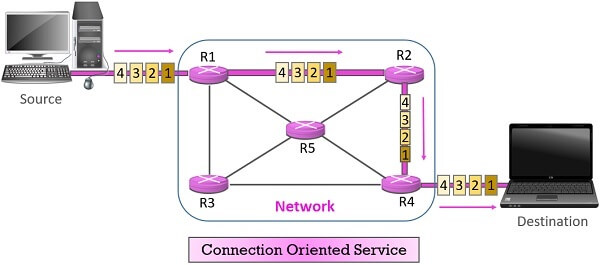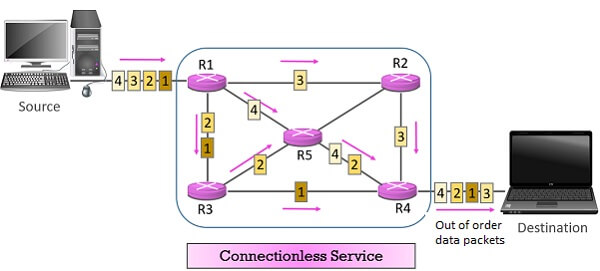Connection oriented and Connectionless services are the two data transmission services provided by the network layer protocols and transport layer protocols. The Connection oriented services establish a connection prior to sending the packets belonging to the same message from source to the destination. On the other hand, the connectionless service considers each packet belonging to the same message as a different & independent entity and route them with a different path.
Connection oriented and connectionless services show different behaviour at the network layer & the transport layer. In this section, we will discuss both the services in-depth and we will also discuss the nature of connection-oriented and connectionless services at both the layers i.e. network layer and transport layer.
Content: Connection Oriented & Connectionless Services
What is Connection Oriented Service?
Connection oriented service is a data transfer method between two computers in a different network, which is designed after the telephone system. Like, in telephone system if we want to talk to someone, we just pick up the phone, dial the number of whom we want to talk with; after the connection is established we talk and lastly, we hang up the call.
Similarly, the connection oriented service first establishes the virtual connection between the source and the destination, then transfers all data packets belonging to the same message through same dedicated established connection and after all packets of a message is transferred it releases the connection.

To establish a connection a source sends a request packet to the destination. In response to which destination sends the acknowledgement packet to the source confirming that the destination is ready to accept the data from the source.
Meanwhile, the routers involved in the exchange of request and acknowledgement packet between source and destination, define the virtual path that will be followed by all packets belonging to the same message. So, we say that the resources involved in data transfer are reserved before transferring all packet in a message.
As all the data packets in a message follow the same path their order is preserved as they reach the destination. After sending all data packets the source sends a special packet to terminate the connection. To which destination sends an acknowledgement confirming the termination of connection and all the router delete the path entry from routing table.
As connection oriented service provide acknowledgement at each action it provides reliability in the service. There are fewer chances of packet loss as they travel a predefined path. The connection oriented services are preferred over a long and steady conversation.
As the virtual path is predefined there are rare or no chances of congestion. If we talk about the delay in data transmission, there is no delay in the transmission of packets as there is a dedicated path for it. But, a substantial delay is introduced due to the acknowledgement process during connection establishment and termination.
The TCP protocol is a connection oriented protocol.
The connection oriented service works the same at both, the network layer and transport layer i.e. first it establishes a connection, exchanges data and terminates the connection. But, it’s behaviour slightly differs at both the layer. Let’s see how?
At Network Layer: At the network layer, the connection oriented service is concerned regarding the coordination of source, destination and routers involved in between the source and destination.
As there is coordination between source, destination and all the routers in between and all packet belonging to the same message follow a dedicated established connection. So, we can implement flow control, error control and congestion control in connection oriented services.
At Transport Layer: At the transport layer, the connection oriented service is concerned only about the source and the destination. Here, the packets show dependency on each other. As all packets will go around the same allocated route.
What is Connectionless Service?
Connectionless service is a method of data transmission between two computers in a different network. Connectionless service is also termed as datagram service. This service look-alike the postal system where each letter carries its source & destination address and each one of them is routed through a different path.
The source divides the message into small acceptable packets these packets known as a datagram. These datagrams are individually pushed into the network; each datagram may travel a different path. The network considers each datagram or data packet as an independent entity i.e. no relationship is considered between the packets belonging to the same message.
Each datagram carries its source and destination address. The router uses the destination address to route the datagram to its destination. The packets received at the destination may be received out of order. Hence, the datagrams are assembled to recreate the original message.

The UDP protocol is a connectionless protocol.
The connectionless service is provided by the protocols of both network layer as well as the transport layer. Though its basic function is the same, i.e. it routes each packet independently over the network may be through different data paths. But still, it behaves slightly different at both the network layer and the transport layer. Let us see how?
At Network Layer: The connectionless service at network layer signifies different path for different data packets belonging to the same message.
At Transport Layer: The connectionless service at transport layer exhibits independency between the packets rather than the different paths that different packets belonging to the same message will follow.
As the data packets belonging to the same message follow the different path it may happen that they are received at the destination out of order. It can also be the case that one of the packets is lost.
At the transport layer, each packet is considered as an independent entity and packets show no relationship with each other. The destination transport layer will not even know that a packet has been lost. Here, we can conclude that we cannot implement flow control, error control, or congestion control in connectionless service.
Key Takeaways
- Connection oriented service is based on the telephone system.
- Connection oriented service first establishes a connection between the source and destination.
- All packets belonging to the same message follows the same dedicated established connection to reach the destination in connection oriented service.
- At the network layer connection oriented service focuses on coordination between source, destination and all the routers between source and destination.
- At the transport layer connection, oriented service is only interested in source and destination. The service here is end to end.
- In connection oriented service we can implement flow control, error control & congestion control.
- Connectionless service is based on the postal services.
- Connectionless service considers each packet of the same message as a different and independent entity. Each data packet carries its source and destination address.
- In connectionless service, each packet of the same message may follow a different route to get delivered to the destination.
- In connectionless service, packets are routed based on the destination address on the packet.
- At the network layer, connectionless service signifies a different route for a different packet belonging to the same message.
- At the transport layer, connectionless service signifies the independency between the packets of the same message.
- In connectionless service, we cannot implement flow control, error control, and congestion control.
Earlier the protocols at the network layer were designed for connectionless service. But, the recent trends allow us to switch to connection oriented services. In the content above we have discussed both the trends, dominant one (connectionless service) and the new one (connection oriented service).

Leave a Reply